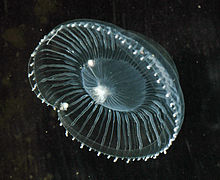| Aequoreidae | |
|---|---|

| |
| Aequorea victoria (the "crystal jelly") with two amphipods | |
| Scientific classification | |
| Domain: | Eukaryota |
| Kingdom: | Animalia |
| Phylum: | Cnidaria |
| Class: | Hydrozoa |
| Order: | Leptothecata |
| Family: | Aequoreidae Eschscholtz, 1829 |
| Genera | |
Aequoreidae is a family of hydrozoans, sometimes called the many-ribbed jellies or many-ribbed jellyfish. There are approximately 30 known species found in temperate and tropical marine coastal environments. Aequoreids include Aequorea victoria, the organism from which the green fluorescent protein gene was isolated.
Polyps
Only the polyp stages of Aequorea species have been observed. The colonies are covered with chitinous periderm and can be either prostrate or erect with weak or sympodial branching. Young hydranths possess hydrothecae with a closing structure called operculum, which consists of several relatively long triangular folds that meet together in the centre when a disturbed polyp contracts. Because the operculum is quite fragile, hydrothecae of old polyps usually have only a small chitinous collar remaining. Comparatively large cylindrical gonothecae are attached to the colony with a thin peduncle. Commonly only one medusa develops in each gonotheca.
Medusae
Mature aequoreid medusae are diverse in shape, from lens-like to conical, and in size. The smallest, Aequerea parva is only 0.6 cm in diameter, while the largest, Rhacostoma atlanticum, can reach 40 cm in diameter. The medusae of most species are between 5 and 15 cm in diameter.
Genera
Aequoreidae includes the following genera:
- Aequorea Péron et Lesueur, 1810 – ca. 20 valid species
- Aldersladia Gershwin, 2006 – 1 valid species
- Gangliostoma Xu, 1983 – 2 valid species
- Rhacostoma L. Agassiz, 1850 – 1 valid species
- Zygocanna Haeckel, 1879 – 5 valid species
See also
References
- ^ Peter Schuchert (2011). Schuchert P (ed.). "Aequoreidae". World Hydrozoa Database. World Register of Marine Species. Retrieved January 20, 2012.
- "Many-ribbed Jellies (Family Aequoreidae)". iNaturalist Canada.
- Pollock, Leland W. (November 5, 1998). A Practical Guide to the Marine Animals of Northeastern North America. Rutgers University Press. ISBN 9780813523996 – via Google Books.
- ^ Kramp, P. L. (1961). Synopsis of the medusae of the world. Journal of the Marine Biological Association of the United Kingdom 40: 1–469. P. 203–212. The full text Archived 2011-09-30 at the Wayback Machine
- Tsien, R. (1998). The green fluorescent protein. Annual Review of Biochemistry 67: 509–44. The full text. doi:10.1146/annurev.biochem.67.1.509.
- ^ Bouillon, J., Gravili, C., Pagès, F., Gili, J. M., Boero, F. (2006). An introduction to Hydrozoa. Mémoires du Muséum national d’Histoire naturelle 194: 1–591, p. 276–278.